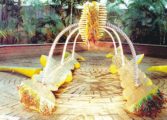Vivek: I think that is very well put. Your vision does not isolate the institution; you are saying that we are in the belly of the beast, that doesn’t mean that one just reproduces everything that is going around.
Geetha: That’s why I am saying DNA because it can be plurality of views. It’s a plurality and diversity, because democracy allows for that. Inherently we need to remain democratic.
Pithamber: So then it becomes a constant vigilance against neo-liberal acceptance of everything.
Geetha: I think we are in an interesting time, economically, politically, and hence ideologically. And we are going to tip over one way or the other. Brexit has seen a breakdown of what that economic order meant in Europe and in England. The rejuvenation of smaller or more local economies is going to ask for greater collaboration as a value because of wanting to survive. There was one monolith which was created by the new modernists, the modernists like Tony Blair and Anthony Giddens.
Vivek: It’s the Left trying to accommodate the right –
Geetha: I think the time for that reflexive modernity—what Giddens and Blair and others tried to do—has gone. Now we are looking at the current political battle that is happening in the United States. If this whole thing breaks wide open, I think we are seeing the end of the kind of globalization we witnessed so far. We will still see technological globalization, but political globalization will more or less come to an end. And I hope with that we will be able to find greater need for regional identities. Even in India we will begin to see, academically, the scholarship will start coming out about the historicity of certain other values, other than neo-liberalism.
There have been so much work done—Gandhi was one person who put forward certain model. This country has had so many alternative kinds of economic and cultural models. They just haven’t had a place to grow. Therefore I am more hopeful that we are the edge of the neo-liberalism and at its waning point. Perhaps a new discourse is emerging. It will be interesting to be watch that –
Pithamber: I have a follow-up question to that. Looking at India historically, we seem to be always out of joint. So before we could develop any of those institutions of modernity that would carry forward the ideology, we had neo-liberalism, but neo-liberalism also has not completely taken hold of us, we are experiencing disruptions. Do you see current conditions as more interesting and opportunistic for India or are we to be in perpetual disjoint?
Geetha: Today we are in a very difficult, dangerous and yet in a place of opportunity. It’s difficult and dangerous because of the number of people in our country and the rising middle-class that is not necessarily well educated, in a critical sense, because the educational system has remained impoverished. They are being told that if a lesson comes to you in a CD-ROMs and if you put DVD on and if they watch a master-class of somebody that is good enough. They are also victims of neo-liberalisation, because they are told they don’t need to know how to ask questions.
So I think that is where India is going educationally. We have to look at government colleges; we have to look at where our kids with SSLC go. We have to create some sort of network with those institutions. That’s where I would say is the challenge. We have to play our role there. Not just let them be abandoned. Because they have not seen a world without neo-liberalism.
Vivek: What do you think about our dependence on the West? Whether it is art or design we always look to the West for critical debates and insights. Why do you think we have not been able to generate those debates ourselves?
Geetha: We are not able to generate those debates amongst ourselves because we constantly create differences between the schooled and unschooled. I find that I learn the most when I go on a rural visit, not necessarily as a tourist to look at villages, but to those places where there are alternative forms of knowledge such as artisanal knowledge. For example, in my last visit to Kutch, I was in a board meeting where I was presented a project to revive the pastoral knowledge systems. Historically, we have had these nomadic communities who do not own land, who move from place to place but who have an intuitive knowledge of place, geography, weather systems. The controversial question that comes up against the pastoral and nomadic societies is that their children do not go to school. The question would be, how would going to school sustain a pastoral and nomadic view of the world? Most of the schooling is about situated economies and societies, not the nomadic ones. I have also seen 2nd and 3rd generational fallout at the level of artisanal knowledge structures where people who had knowledge about processes, materials, metals and forms of metallurgy are completely devalued when they entered public school system in the rural communities. I think there are enough knowledge systems in arts of our country that could be revived if there are generations that are still alive (who would be young grandparents now), and if we redesigned curriculum that is not centralized and set by board, it would allow for more localized scholarship to emerge. It could be that they need to do this from Kindergarten to 12 but what exactly goes into it need to be decided. There could be elements from the centralized system, but a lot could come from localized knowledge practices. I think that this is where when we say believe in India, we have to go back and find what actually India knows and say that we value what it knows. We many not able to go back and use what it knows effectively in the neoliberal and commercialized market sense, but fortunately the technology is making that gap less. Artisans are saying today that they do not need intermediaries anymore, they can market directly to the consumer. The e-commerce technology is bringing the frontend directly to the doorstep of the artisans. But the question is do we value what that artisan knows? The knowledge structures in so many places are rooted in culture, it is linked to cultural knowledge. Tacit knowledge and cultural knowledge are critical for economy. For us to believe in India we have to change our perception of the economic order and then education will follow.
You cannot believe in India if you do not value the Indian artist or artisan at the same level as you value an international artist. If you believe in India you have to say that there is enough scholarship and knowledge in India that merits bringing it to the forefront, not necessarily using it. At least bringing it out into the open and saying that it is there. Acknowledge it. I am not calling it indigenous knowledge or vernacular knowledge – These are unfortunate labels. Knowledge is knowledge. By saying it this is what the native Americans are saying or the Aboriginals are saying or the tribes are saying you are giving it a status.
Vivek: That is for the museum. That brings me to one question that I meant to ask you. After interacting with you I have been thinking about curriculum and the learning spaces. That is where I see you making connections.
Geetha: All the time.
Vivek: Some times it is difficult to understand and it is not always clear, but I have not seen anyone who self-consciously make that connections. Would you like to elaborate on that?
Geetha: I have been influenced so much by people like Michael Apple from US, who says that there is a connection between ideology and curriculum. In order to understand curriculum you have to understand the ideology – ideology and curriculum are hand-in-glove. He says that anything that you choose to present before the students is an act of pedagogical choice. That choice is by a public intellectual, a teacher, a scholar or an academic (I am using the word public intellectual in the way that Henry Giroux and others have articulated). Because of that I am conscious of the second phenomenon, of choosing what not to put before our students—the null curriculum. If we say in design education all our students come to us and say we do not want a critical course instead we want a more skill based course like typography or some other course, we can show that the meme works. Now 45 students will signup just to learn to do something on the computer, because their vision of skill is linked to an economic order. When they are doing that, the voice in my head is saying, when they do what they want, what is it that they are not getting? What is the null? I am always analyzing and trying to find space for what they are not getting. It may not be something that I do have affinity to, but let us identify what is that zero and try to inject something into that zero even if it is during the Interim semester.
That is why I am trying to hug – Revisiting – which I am saying, is a space that is not there in any university space. Interim is also this wide open space, the Interlude, Seminar. How we use these spaces is very important for me. It is important to target the null curriculum. Because it can be a place where we meme bust. It can be a place where the connections between the ideology and what they learn can be explicitly and overtly analyzed. It can be a place to gather experience in what they don’t have any experience in. May be you want to articulate the MA class as a space for creative making because the MA students have typically come from more theoretical background, and when they use their hands for making, they may change their point of view completely, because then they are thinking like artisans or crafts people and trying to understand what it means.
So my thing is that the ideology and curriculum are linked. And that the dominant thing tends to self perpetuate through trajectories of education that our faculty themselves have gone through. That forming spaces like Revisiting, seminar, Interim, interlude in Srishti is very valuable because you cannot fight the majority, but you must have institutional space where the null curriculum is exposed and so that people can actually see that and find ways in which the students and faculty can remain open minded. If it is open and not judged then it will evolve into something of its own merit. That is why I bring an artist is residence or a scholar in residence. We have Ilango, but people have not understood yet that he brings s very rich knowledge of mathematics and Sangam literature into his practice. He is a philosopher. Now it would be nice if people went and found out more about what he is doing. I can do only the disruptive activity of bringing him in, but I cannot push it. Then it would become an agenda. So I also have to know when and where to stop so that I do not become a propaganda machine. So there is a fine line between null curriculum and being provocative, between propaganda and allowing structure and space. What I have done really is to create structure and space in pedagogy. Two weeks of workshop and working in cycles allows the students to see many different people, diverse modes of learning and become more resilient as a result.
Geetha Narayanan is Founder Director of Srishti Institute of Art Design & Technology; Principal Investigator of Project Vision, a Director’s Fellow at the Media Lab, MIT, USA and a visiting faculty at the Future of Learning Institute at Harvard Graduate School of Education USA.





